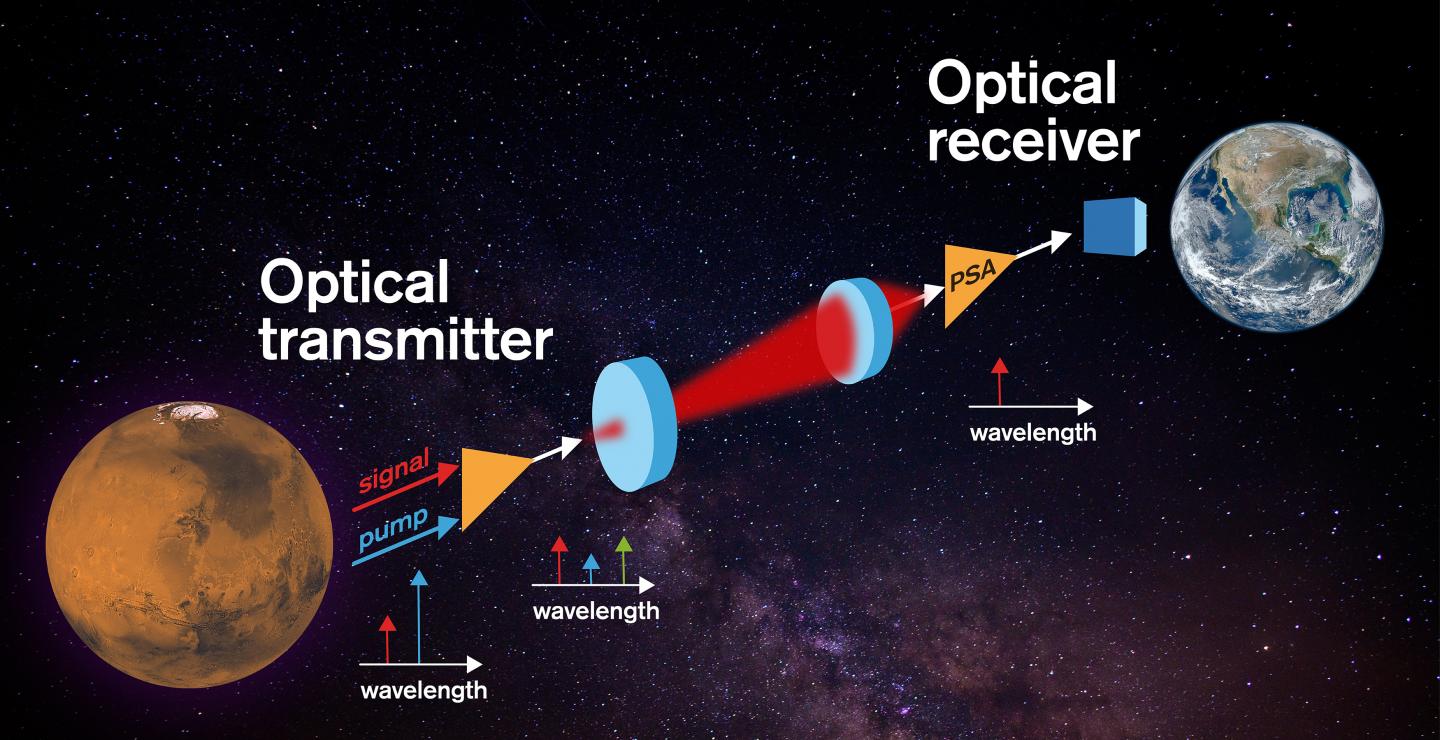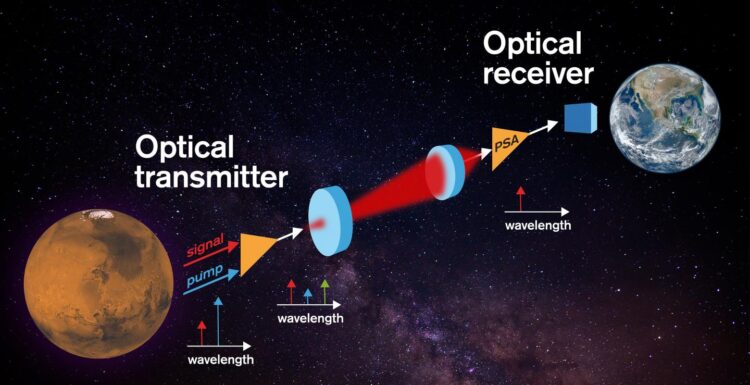
Credit: Yen Strandqvist/Chalmers University of Technology
Communications in space demand the most sensitive receivers possible for maximum reach, while also requiring high bit-rate operations. A novel concept for laser-beam based communications, using an almost noiseless optical preamplifier in the receiver, was recently demonstrated by researchers at Chalmers University of Technology, Sweden.
In a new paper published in the scientific journal Nature: Light Science & Applications, a team of researchers describes a free-space optical transmission system relying on an optical amplifier that, in principle, does not add any excess noise – in contrast to all other preexisting optical amplifiers, referred to as phase-sensitive amplifiers (PSAs).
The researchers’ new concept demonstrates an unprecedented receiver sensitivity of just one photon-per-information bit at a data rate of 10 gigabits per second.
“Our results show the viability of this new approach for extending the reach and data rate in long-distance space communication links. It therefore also has the promise to help break through the present-day data-return bottleneck in deep-space missions, that space agencies around the world are suffering from today,” says Professor Peter Andrekson, head of the research group and author of the article together with PhD Ravikiran Kakarla and senior researcher Jochen Schröder at the Department of Microtechnology and Nanoscience at Chalmers University of Technology.
Substantially increasing the reach and information rate for future high-speed links will have big implications for technologies such as inter-satellite communication, deep-space missions, and earth monitoring with light detection and ranging (Lidar). Systems for such high-speed data connections are increasingly using optical laser beams rather than radio-frequency beams. A key reason for this is that the loss of power as the beam propagates is substantially smaller at light wavelengths, since the beam divergence is reduced.
Nevertheless, over long distances, light beams also experience large loss. For example, a laser beam sent from the Earth to the Moon – around 400,000 kilometres – with a 10 cm aperture size, will experience a loss of power of around 80 dB, meaning only 1 part in 100 million will remain. As the transmittable power is limited, it is of critical importance to have receivers that can recover the information sent with as low power received as possible. This sensitivity is quantified as the minimum number of photons per information bit necessary to recover the data without error.
In the new concept from Chalmers, information is encoded onto a signal wave, which along with a pump wave at different frequency generates a conjugated wave (known as an idler) in a nonlinear medium. These three waves are launched together into the free space. At the receiving point, after capturing the light in an optical fiber, the PSA amplifies the signal using a regenerated pump wave. The amplified signal is then detected in a conventional receiver.
“This approach fundamentally results in the best possible sensitivity of any pre-amplified optical receiver and also outperforms the all other current state-of-the-art receiver technologies,” says Peter Andrekson.
The system uses a simple modulation format encoded with a standard error correction code and a coherent receiver with digital signal processing for signal recovery. This method is straightforwardly scalable to much higher data rates if needed. It also operates at room temperature, meaning it can be implemented in space terminals and not only on the ground.
The theoretical sensitivity limits of this approach are also discussed in the paper and compared to other existing methods, with the conclusion that the new approach is essentially the best possible for a very broad range of data rates.
###
Contact
Peter Andrekson, Professor of Photonics, Head of the Photonics Laboratory, Department of Microtechnology and Nanoscience – MC2,
Chalmers University of Technology
[email protected]
Read the article in Nature: Light Science and Applications
https:/
Ravikiran Kakarla, Jochen Schröder, and Peter A. Andrekson. One photon-per-bit receiver using near-noiseless phase-sensitive amplification. Nature: Light Science & Applications 9, 153 (2020).
Funding
This work was supported by the Swedish Research Council (grant VR-2015-00535), the Knut and Alice Wallenberg Foundation, and the European Research Council (project ERC-2018-PoC 813236).
More about the research
A widely studied approach uses power-efficient pulse position modulation formats along with nanowire-based photon-counting receivers needing cooling down to only a few Kelvin while operating at speeds below 1 Gbit/s. However, to achieve multi-Gbit/s data-rates that will be required in the future, systems relying on pre-amplified optical receivers together with advanced signal generation and processing techniques used in optical fiber communications are also being considered.
With their new method, the Chalmers researchers demonstrated an unprecedented error-free, “black-box”-sensitivity of one photon-per-information-bit at a data rate of 10 Gbit/s. With 10 Watts of transmitter power, this receiver would allow for a link loss of 100 dB at this data rate. For transmission to/from Mars, a system with 10 Watts could support a data rate in the order of 10 Mbit/s, which is about 1000 faster than today’s rates (0.5-32 kbit/s).
Media Contact
Joshua Worth
[email protected]
Related Journal Article
http://dx.





